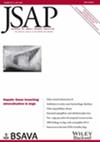Long-term clinical outcomes of healthy dogs with increased alanine aminotransferase
Abstract
Objectives
To define a reference interval for alanine aminotransferase for the practice laboratory and then identify and longitudinally follow the clinical health and alanine aminotransferase levels in a cohort of clinically healthy dogs with increased alanine aminotransferase levels documented during wellness screening.
Materials and Methods
Alanine aminotransferase levels of 125 clinically healthy dogs were used to define a reference interval for the practice laboratory. The electronic records of 315 clinically healthy dogs which had undergone wellness screening including assessment of alanine aminotransferase levels at a first-opinion veterinary hospital in the UK were reviewed between January 2012 and January 2023. Clinically healthy dogs with increased alanine aminotransferase levels relative to the top of the reference interval determined for the practice on at least one test during the study period were identified. These were longitudinally followed through electronic medical records to determine their long-term clinical outcomes over a period of up to 11 years.
Results
The reference interval for alanine aminotransferase in the practice laboratory was calculated as 10.6 to 181.8 U/L. Nineteen clinically healthy dogs were identified as having increased alanine aminotransferase levels. One dog from the group with increased alanine aminotransferase levels was diagnosed with chronic hepatitis and died of liver failure, while the other 18 dogs died of other causes, or were still alive at the end of the study, with no clinical signs associated with liver disease. One dog in the group with consistently normal alanine aminotransferase levels also died from clinical signs attributed to liver disease.
Clinical Significance
Only a small proportion of clinically healthy dogs with increased alanine aminotransferase levels documented on wellness screening developed clinically relevant liver dysfunction over long-term follow-up.

 求助内容:
求助内容: 应助结果提醒方式:
应助结果提醒方式:


